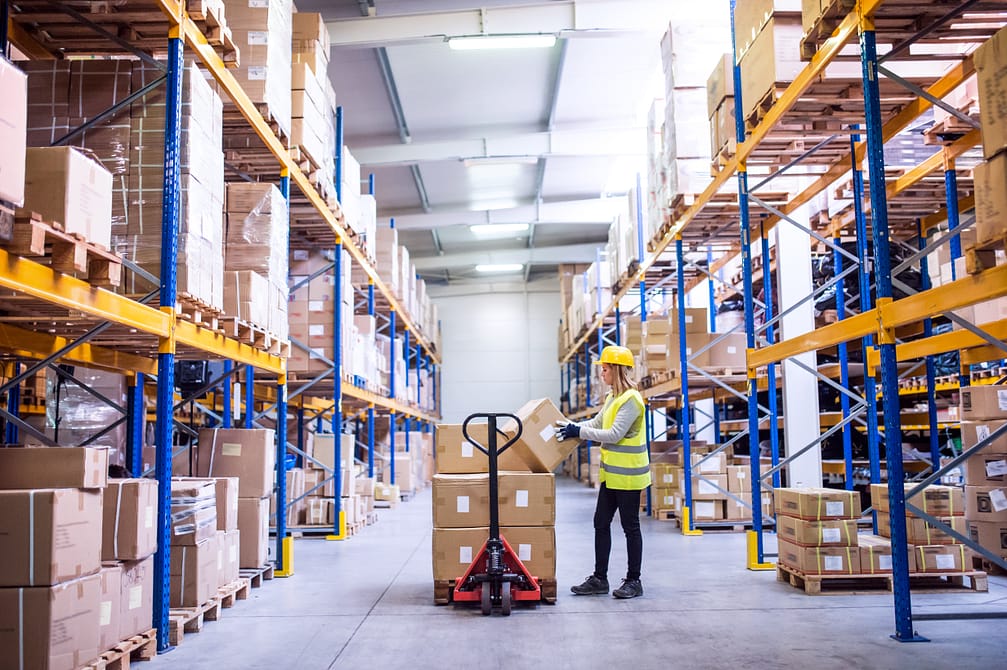Warehouses can be a dangerous place to work in. With so many moving parts, it’s important to understand common warehouse hazards because they can lead to injuries and, in extreme cases, death.
According to the Occupational Safety and Health Administration (OSHA), the rate of fatal injuries in the warehousing industry is higher than the national average for all other industries. Potential hazards for workers in warehousing include:
- Unsafe use of forklifts
- Improper stacking of products
- Failure to use proper personal protective equipment (PPE)
- Failure to follow proper lock-out/tag-out procedures
- Inadequate fire safety provisions
- Repetitive motion injuries
The OSHA makes it their mission to ensure the safety and health of America’s workers by setting and enforcing standards, by providing training, outreach, education, establishing partnerships, and encouraging continual process improvements in workplace safety and health.
In this blog, we’ll discuss a few warehouse safety tips to follow to ensure you’re protecting your employees, products, and warehouse from accidents, regardless of business or industry.
Warehouse Safety Checklist
1. Provide Warehouse Safety Training
Every workplace has its own rules and regulations. Warehouses are no exception. And because the processes and procedures in a warehouse can be complicated and lengthy, training is especially important in this line of work.
Through regular warehouse safety training programs, such as general ergonomics training and task-specific training, you can keep your staff up to date with how they can avoid unsafe working practices. Adequate training not only encourages people to follow procedures more closely, but it helps to maintain a safe, efficient work environment.
2. Install Warehouse Safety Signs
Warehouse safety signs are the most cost-effective way to keep your warehouse organized and safe from hazardous situations. These signs can be displayed on floors, racks, equipment, and materials to help prevent serious injuries. When using safety signage in warehouses, consider the following:
- Safety equipment reminders: For warehouses that utilize forklifts and other heavy machinery, it’s important to remind employees to wear the required/recommended PPE. Under OSHA law, employers are required to provide the properly fitting PPE that corresponds with the level of hazard present.
- Hazardous zones: Specific warehouse safety signs are required to remind employees of the potential dangers in areas that are prone to danger, such as next to power generators or high-traffic areas for machinery.
- Emergency signage: Clearly label fire extinguishers, first aid kits, eyewash stations, equipment shutoffs, and emergency exits.
- Training and safety reminders: Keep your warehouse safe and productive with signage that reminds employees of the training and safety requirements for operating certain equipment.
3. Ensure the Use of Effective Lighting
Oftentimes, lighting is overlooked in the broader approach to warehouse safety. Proper lighting improves safety for workers and protects the health of your business. If employees are unable to see hazards, it becomes difficult to avoid those hazards. A well-lit warehouse drastically minimizes the likelihood of:
- Heavy-equipment accidents
- Losses and damages to property
- Dangers caused by poor stacking of products
- Forklifts striking people
4. Have Working Fire Suppression Systems
Having a well-installed and maintained fire sprinkler system in your warehouse is the single most important fire protection measure you can take. Depending on the product being stored, different fire sprinkler requirements are needed.
- Class I: These products are non-combustible materials stored on pallets, single-layered.
- Class II: These products are non-combustible materials stored in wooden crates, multilayered.
- Class III: These products are made from wood, paper, natural fibers, and Group C plastics.
- Class IV: These products are Group B plastics or partial Group A plastics.
If you’re selecting a new pallet-racking system, for instance, your municipality may require a sprinkler system be installed, depending on what you’re storing, how much you’re storing, and the size of your system.
5. Ventilate
Proper ventilation is a crucial part of warehouse safety, but, just like lighting, it’s often overlooked. The fact of the matter is that limited air circulation can lead to stagnation of fumes and vehicle exhaust in a warehouse, which can negatively affect employee comfort and safety. It’s important to get the airflow of your warehouse checked and ensure adequate ventilation is maintained, especially in high-traffic areas.
Create a Safe Working Environment
Every industry must adhere to strict safety measures when it comes to employees and equipment. From distribution centers and manufacturing facilities to retail backrooms and automotive shops, one of the best investments you can make in your business is protecting your employees, products, and factory from accidents.
Accidents can be costly. With cost-effective industrial safety products, you can ensure you are doing your part to reduce the risk of injury and provide reliable solutions within your warehouse.
Conveyer & Caster offers a full suite of products, including guardrails, safety barriers, column and rack protectors, anti-fatigue matting, and more. Contact us today and let us leverage our industry-leading safety products and ergonomic solutions to create a safer, more comfortable work environment for your team.








